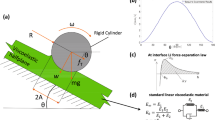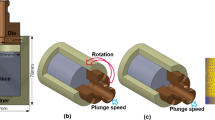Abstract
The physical meaning of the characteristic displacement that has been observed in velocity-stepping friction experiments was investigated based on the micromechanics of asperity contact. It has been empirically found for bare rock surfaces that the magnitude of the characteristic displacement is dependent only on surface roughness and insensitive to both slip velocity and normal stress. Thus the characteristic displacement has been interpreted as the displacement required to change the population of contact points completely. Here arises a question about the physical mechanism by which the contact population changes. Because individual asperity contacts form, grow and are eliminated with displacement, there are at least two possible interpretations for the characteristic displacement: (1) it is the distance over which the contacts existing at the moment of the velocity change all fade away, being replaced by new asperity contacts, or (2) it is the distance required for a complete replacement in the real contact area that existed at the moment of the velocity change. In order to test these possibilities, theoretical models were developed based on the statistics of distributed asperity summits. A computer simulation was also performed to check the validity of the theoretical models using three-dimensional surface topography data with various surface roughnesses. The deformation was assumed to be elastic at each asperity contact. The results of both the simulation and the theoretical models show that the characteristic displacement in (1) is about three times longer than that in (2). Comparison of the results with the experimental observations obtained by others indicates that the possibility (2) is the correct interpretation. This means that the “state” in the rate and state variable friction law is memorized in a very confined area of real contact. Further, our results explain why the characteristic displacement is insensitive to normal stress: this comes from the fact that the microscopic properties such as the mean contact diameter are insensitive to normal stress. The approach based on the micromechanics of asperity contact is useful to investigate the underlying mechanism of various phenomena in rock friction.
Similar content being viewed by others
References
Biegel, R. L., Sammis, C. G., andDieterich, J. H. (1989),The Frictional Properties of a Simulated Gouge Having a Fractal Particle Distribution, J. Structural Geol.11, 827–846.
Boitnott, G. N., Biegel, R. L., Scholz, C. H., Yoshioka, N., andWang, W. (1992),Micromechanics of Rock Friction, 2: Quantitative Modeling of Initial Friction With Contact Theory, J. Geophys. Res.97, 8965–8978.
Brown, S. R., andScholz, C. H. (1985),Closure of Random Elastic Surfaces in Contact, J. Geophys. Res.90, 5531–5545.
Brown, S. R., andScholz, C. H. (1986),Closure of Rock Joints, J. Geophys. Res.91, 4939–4948.
Dieterich, J. H. (1978),Time-dependent Friction and the Mechanics of Stick-slip, Pure and Appl. Geophys.116, 790–806.
Dieterich, J. H. (1979),Modeling of Rock Friction 1. Experimental Results and Constitutive Equations, J. Geophys. Res.84, 2161–2168.
Dieterich, J. H. (1981),Constitutive properties of faults with simulated gouge. In:Mechanical Behavior of Crustal Rocks (eds.Carter, N. L. Friedman, M., Logan, J. M., andStearns, D. W.) Geophys. Monogr.24 (American Geophys. Union) pp. 103–120.
Dieterich, J. H., andKilgore, B. D. (1994),Direct Observation of Frictional Contacts: New Insights for State-dependent Properties, Pure and Appl. Geophys.143, 283–302.
Greenwood, J. A., andWilliamson, J. (1966),Contact of Nominally Flat Surfaces, Proc. R. Soc., London, Ser. A.295, 300–319.
Johnson, K. L.,Contact Mechanics (Cambridge Univ. Press, New York 1985).
Marone, C., andKilgore, B. (1993),Scaling of the Critical Slip Distance for Seismic Faulting with Shear Strain in Fault Zones, Nature362, 618–621.
Marone, C., andCox, S. J. D. (1994),Scaling of Rock Friction Constitutive Parameters: The Effects of Surface Roughness and Cumulative Offset on Friction of Gabbro, Pure and Appl. Geophys.143, 359–385.
Papoulis, A.,Probability, Random Variables, and Stochastic Processes (McGraw-Hill, New York 1965).
Rabinowicz, E. (1965),Autocorrelation Analysis of the Sliding Process, J. Appl. Phys.27, 131–135.
Ruina, A. L. (1983),Slip Instability and State Variable Friction Laws, J. Geophys. Res.88, 10359–10370.
Sammis, C. G., andSteacy, S. J. (1994),The Micromechanics of Friction in a Granular Layer, Pure and Appl. Geophys.143, 777–794.
Scholz, C. H., andEngelder, J. T. (1976),The Role of Asperity Indentation and Plaughing in Rock Friction: I. Asperity Creep and Stick-slip, Int. J. Rock Mech. Min. Sci. and Geomech. Abstr.13, 149–154.
Swan, G. (1983),Determination of Stiffness and Other Joint Properties from Roughness Measurement, Rock Mech. Rock Eng.16, 19–38.
Walsh, J. B., andGrosenbaugh, M. A. (1979),A New Model for Analyzing the Effect of Fractures on Compressibility, J. Geophys. Res.84, 3532–3536.
Wang, W., andScholz, C. H. (1994a),Wear Processes During Frictional Sliding of Rock: A Theoretical and Experimental Study, J. Geophys. Res.99, 6789–6799.
Wang, W., andScholz, C. H. (1994b),Micromechanics of the Velocity and Normal Stress Dependence of Rock Friction, Pure and Appl. Geophys.143, 303–315.
Wang, W., andScholz, C. H. (1995),Micromechanics of Rock Friction, 3. Quantitative Modeling of Base Friction, J. Geophys. Res.100, 4243–4247.
Wong, T.-F., Fredrich, J. T., andGwanmesia, G. D. (1989),Crack Aperture Statistics and Pore Space Fractal Geometry of Westerly Granite and Rutland Quartzite: Implications for an Elastic Contact of Rock Compressibility, J. Geophys. Res.94, 10267–10278.
Yoshioka, N. (1994a),Elastic Behavior of Contacting Surfaces under Normal Loads: A Computer Simulation Using Three-dimensional Surface Topographies, J. Geophys. Res.99, 15549–15560.
Yoshioka, N. (1994b),The Role of Plastic Deformation in Normal Loading and Unloading Cycles, J. Geophys. Res.99, 15561–15568.
Yoshioka, N., andScholz, C. H. (1989a),Elastic Properties of Contacting Surfaces Under Normal and Shear Loads, 1. Theory, J. Geophys. Res.94, 17681–17690.
Yoshioka, N., andScholz, C. H. (1989b),Elastic Properties of Contacting Surfaces Under Normal and Shear Loads, 2. Comparison of Theory With Experiment, J. Geophys. Res.94, 17691–17700.
Author information
Authors and Affiliations
Rights and permissions
About this article
Cite this article
Yoshioka, N., Iwasa, K. The characteristic displacement in rate and state-dependent friction from a micromechanical point of view. PAGEOPH 147, 433–453 (1996). https://doi.org/10.1007/BF00878837
Received:
Accepted:
Issue Date:
DOI: https://doi.org/10.1007/BF00878837




